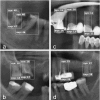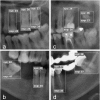Tooth detection and numbering in panoramic radiographs using convolutional neural networks
- PMID: 30835551
- PMCID: PMC6592580
- DOI: 10.1259/dmfr.20180051
Tooth detection and numbering in panoramic radiographs using convolutional neural networks
Abstract
Objectives: Analysis of dental radiographs is an important part of the diagnostic process in daily clinical practice. Interpretation by an expert includes teeth detection and numbering. In this project, a novel solution based on convolutional neural networks (CNNs) is proposed that performs this task automatically for panoramic radiographs.
Methods: A data set of 1352 randomly chosen panoramic radiographs of adults was used to train the system. The CNN-based architectures for both teeth detection and numbering tasks were analyzed. The teeth detection module processes the radiograph to define the boundaries of each tooth. It is based on the state-of-the-art Faster R-CNN architecture. The teeth numbering module classifies detected teeth images according to the FDI notation. It utilizes the classical VGG-16 CNN together with the heuristic algorithm to improve results according to the rules for spatial arrangement of teeth. A separate testing set of 222 images was used to evaluate the performance of the system and to compare it to the expert level.
Results: For the teeth detection task, the system achieves the following performance metrics: a sensitivity of 0.9941 and a precision of 0.9945. For teeth numbering, its sensitivity is 0.9800 and specificity is 0.9994. Experts detect teeth with a sensitivity of 0.9980 and a precision of 0.9998. Their sensitivity for tooth numbering is 0.9893 and specificity is 0.9997. The detailed error analysis showed that the developed software system makes errors caused by similar factors as those for experts.
Conclusions: The performance of the proposed computer-aided diagnosis solution is comparable to the level of experts. Based on these findings, the method has the potential for practical application and further evaluation for automated dental radiograph analysis. Computer-aided teeth detection and numbering simplifies the process of filling out digital dental charts. Automation could help to save time and improve the completeness of electronic dental records.
Keywords: computer-aided diagnostics; convolutional neural networks; panoramic radiograph; radiographic image interpretation; teeth detection and numbering.
Figures








References
-
- Rezaei M , Yang H , Meinel C . Deep Neural Network with l2-norm Unit for Brain Lesions Detection . In : International Conference on Neural Information Processing ; 2017. . pp . 798 – 807 .
-
- ISO ISO 3950:2016 Dentistry-Designation system for teeth and areas of the oral cavity . 2016. ;. - PubMed
-
- Lin PL , Lai YH , Huang PW . An effective classification and numbering system for dental bitewing radiographs using teeth region and contour information . Pattern Recognition 2010. ; 43 : 1380 – 92 . doi: 10.1016/j.patcog.2009.10.005 - DOI
MeSH terms
LinkOut - more resources
Full Text Sources
Other Literature Sources

